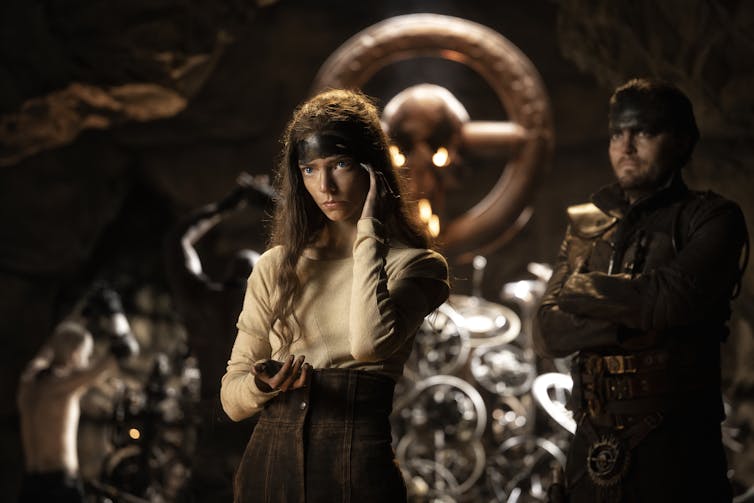When George Miller was directing Anya Taylor-Joy in the role of Furiosa, Taylor-Joy says he told her:
‘mouth closed, no emotion, speak with your eyes’. That’s it, that’s all you have.
Taylor-Joy has only 30 lines of dialogue, but in the first half of the film Furiosa is played (admirably) by a younger actor, Alyla Browne.
But even when Furiosa doesn’t speak, the new films are a huge step forward for the portrayal of women’s stories in the Mad Max world.
Science-fiction disaster films
Max is silent for much of the first four films and he does not appear in Furiosa (if you discount the glimpse we see of him on a hillside). Our heroes have little to say with words, but the villains are more verbose. In Furiosa, Hemsworth’s Dementous is objectionably loquacious.
The early Mad Max films are largely uninterested in women. After his wife Jessie dies in the first film, Max shows no interest in women sexually. But there is an underlying theme relating to the survival and fertility of women, while keeping the narrative focus firmly on the men.
One way to read the Mad Max film cycle is as an Antipodean response to themes first explored in 1950s science-fiction disaster films such as Five (1951), Captive Women (1952), World Without End (1956) and Last Woman on Earth (1960). In these films, nuclear destruction results in an environmentally devastated world where male survivors compete for access to resources like fuel, technology and fertile women.
In the first Mad Max film, from 1979, as civilisation descends into chaos, women and families are quickly eliminated. Bikers kill Max’s wife and son. Fleeting appearances of other women like bikie “molls” or victims of sexual assaults on the road highlight how women are marginalised. The last woman to appear in the first film is May, an the old woman who attempts to help the Rockatansky family, but in her hands both a car and a shotgun are ineffectual.
In Mad Max 2 (1981), once the able Warrior Woman dies in battle, the role of the few surviving female characters is reproductive. Curmudgeon informs Max the survivors’ chief function will be performed in Queensland, where they will be required to “breeeeeed”.
Despite Tina Turner’s star presence in Beyond Thunderdome (1985) as an “aunty” rather than a mother-figure, women continue to play secondary roles to Max and to the vehicular action, with just hints that Savannah Nix, the leader of the lost children, may signal a future where women have more power and agency.
Women get star billing
Furiosa has good reason to stay silent. This latest film traces how, as a young girl and a woman, she is held captive first by Dementous and then by Immortan Joe.
Her silence is strategic: it lends her power, and disguises her gender when she reaches puberty. Furiosa understands that, unless she is able to fight and drive, her function will be to bear children. When she attracts sexual attention, she disguises herself as a boy and learns how to drive and how to assemble a vehicle.

These are the skills that will ensure her survival and eventual hero status. Better to be a prize driver than one of Joe’s “prize breeders”. We learn more about her character when we witness how she loses her arm than could possibly be articulated by dialogue.
What is more interesting than Furiosa’s selective muteness in both recent films is her star billing and her status as a driver and a warrior. Decades after the original films, women finally get significant screen time.
In the fourth film, Fury Road (2015), Max not only shares the role of protagonist and heroic driver with Furiosa (here played by Charlize Theron), but most of the central characters are women: the Five Wives, the Valkyrie and the Many Mothers (wizened competent bikies) are members of the Vuvalini tribe from the Green Place.
Apart from the first scene where the War Boys pursue Max, almost every frame in Fury Road includes a woman as a central part of the action. This continues in Furiosa.
Again echoing tropes established in 1950s sci-fi, in both Furiosa and Fury Road a healthy womb is a valuable commodity.
Much like cars are treated as spare parts throughout the series, and in films like The Cars that Ate Paris (1974), humans are tagged with tattoos listing their viable parts and are traded as “blood bags”. Joe’s treasures in Fury Road are beautiful young women he selects as breeding stock. He keeps his Five Wives captive in a chamber resembling a giant bank vault.
By shifting the focus of the Mad Max films from the men to the women, we finally have a complex portrayal of the women in this environment and their reduction to their reproductive possibilities.
It isn’t without its problems. At various points in Fury Road, the wives – clad in bikinis and chastity belts as if straight off a Victoria’s Secret catwalk – repeat mantras protesting their objectification and lack of agency in this toxic patriarchy. Yet while the film speaks criticism of objectification, it profits off that same objectification. Miller draws our attention to the exploitation of women and how they are treated as aesthetic breeders while offering up scantily clad models.
Despite this double standard, it is thrilling to see Browne and Taylor-Joy centre stage as warriors driving the rig and the narrative in Furiosa. This is progress – if we remember that bikinis as well as car crashes sell cinema tickets.

